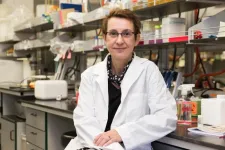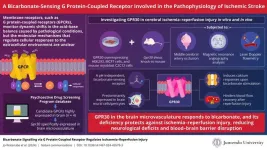(Press-News.org) BINGHAMTON, N.Y. -- Binghamton University, State University of New York researcher Karin Sauer is among 65 scientists elected as Fellows of the American Academy of Microbiology this year.
Fellows are elected by their peers based on their scientific achievements and original contributions to the field of microbiology.
Sauer’s lab aims to find ways to control communities of bacteria called biofilms and to curb their extraordinary resistance to antimicrobial agents. The team’s findings could have an impact on a wide range of healthcare practices, from ear infections to wound care.
“I’m honored and excited by this recognition of my career to date,” says Sauer, co-founder of one of the largest American biofilm research groups. “I think the next decade will see some tremendous progress in applying our work to improve human health, especially for people who have surgically implanted medical devices.”
Sauer, who earned a doctorate from the Max Planck Institute for Terrestrial Microbiology in Germany, joined Binghamton’s faculty in 2003 and was promoted to professor in 2013. A recent Stanford University study that looks at the impact of scientists worldwide named Sauer among the top 2% of researchers in the world in their fields.
Sauer serves as editor-in-chief for FEMS Microbiology Reviews, the fifth-highest-ranked microbiology journal. She’s also an editor of mBio, the Biofilm journal and Environmental Microbiology and Microbiology Reports.
Sauer, whose work has been funded by government agencies and industrial sponsors, has brought about $13 million in research grants to Binghamton. She is an organizer of the Approaching Zero Roadmap Initiative, which offers an international virtual seminar series where researchers discuss device-associated infections.
Sauer, a first-generation immigrant scholar herself, said mentoring the next generation of scientists is especially important to her. A founding faculty member of Binghamton University’s First-year Research Immersion program, she’s the co-director of a Research Experiences for Undergraduates summer program and a mentor for students in the Bridges to the Baccalaureate and McNair Scholars programs, which serve students from minoritized backgrounds.
“My approach to mentoring and to diversity is simple,” Sauer said. “It’s about cultivating a culture where all can bring their authentic selves to work.”
The American Society for Microbiology, one of the largest professional societies dedicated to the life sciences, counts some 36,000 scientists and health practitioners among its members. The academy received 156 nominations for Fellows this year.
“Fellows are an outstanding assembly of scientists whose contributions have propelled our discipline and whose knowledge benefits both the scientific community and broader society,” said Vanessa Sperandio, chair of the Academy Governors.
END
Binghamton University biologist named Fellow of American Academy of Microbiology
Karin Sauer's research centers on biofilms and curbing their resistance to antibiotics
2024-02-27
ELSE PRESS RELEASES FROM THIS DATE:
Community culture shapes ceramics
2024-02-27
Archeologists have long used the shapes and styles of pottery as a proxy for ancient cultures. But how does the cultural alignment of ceramic forms arise? To explore this question, Tetsushi Nonaka and colleagues asked 21 potters in three different communities—one in France in Bourgogne and two in India in Bulandshahar district, Uttar Pradesh—to throw pots with the same unfamiliar shapes. One of the Indian pottery workshops was Hindu, the other was Muslim. In each community, several different potters tried the shapes. Through careful measurement, the authors were able to determine ...
Nano-sized particles emitted from gas stoves
2024-02-27
A study quantifies the emission of extremely tiny particles by gas stoves and finds that the particles could harm human health. Airborne nanoparticles between 1–3 nm, referred to as nanocluster aerosol or NCA, are known to be bioactive and toxic, but measuring such minute particles has been a challenge. Brandon E. Boor and colleagues measured indoor NCA during propane gas cooking in the Purdue zero Energy Design Guidance for Engineers (zEDGE) test house using a novel instrument. Combining measurement data with the general dynamic equation for aerosols, the authors were able to characterize the production and behavior ...
Reproducing the Moon's surface environment on Earth
2024-02-27
Continuous research is being conducted globally on using the Moon as an advanced base for deep space exploration, and Korea is no exception in these efforts. The Korea Institute of Civil Engineering and Building Technology (KICT, President Kim, Byung-suk) successfully implemented an electrostatic environment that simulates the Moon's surface conditions, not in space but on Earth. The researchers also assessed its performance and effectiveness.
Among the most serious threats in executing lunar missions is the Moon's surface environment, which is electrostatically charged. Due to its extremely thin atmosphere, the Moon is directly exposed to solar ultraviolet rays, X-rays, ...
Social media and adolescent mental health
2024-02-27
In an editorial, Sandro Galea and Gillian Buckley summarize the findings of a National Academies of Sciences, Engineering, and Medicine consensus study report on social media and adolescent mental health. Social media has to some extent been treated as a monolith, but the report finds that different types of engagements with different digital platforms may have very different effects on mental health. In some situations, social media may benefit adolescent mental health, as when LGBTQ+ adolescents in isolating circumstances are able to form supportive ...
How decades of expertise with the fourth state of matter could bring satellites closer to Earth
2024-02-27
Thousands of satellites take pictures, gather information and relay internet traffic from high above the Earth. Now, the challenge is making satellites that operate closer to home, in what is called a very low earth orbit (VLEO), where there is ample space for additional satellites, and the pictures taken would be clearer.
Working at an altitude with air would mean more force would be needed to propel the satellite forward, but many scientists believe there is also an advantage: the air could be used as the propellant. They say charged particles of air-breathing plasma – the fourth state of matter – could be used to propel the thrusters, potentially ...
Living near pubs, bars and fast-food restaurants could be bad for heart health
2024-02-27
Research Highlights
Closer proximity to and a higher number of ready-to-eat food outlets — particularly pubs, bars and fast-food restaurants — may be associated with a greater risk of developing heart failure, according to a study of half a million adults in the UK Biobank.
The association between food environments and increased heart failure risk was stronger among people who did not have a college degree and those living in urban areas without access to facilities for physical activity such as gyms or fitness centers.
Embargoed until 4 a.m. CT/5 a.m. ET Tuesday, Feb. 27, 2024
DALLAS, Feb. 27, 2024 — Living close to pubs, bars and fast-food restaurats may ...
Research adds to knowledge about heart disease and stroke in women of all ages
2024-02-27
Research Highlights:
Women’s heart disease and stroke risks and outcomes differ throughout life in comparison to men.
A special Journal of the American Heart Association “spotlight” issue features a collection of the latest research about sex differences in cardiovascular disease and their implications for gender-specific care.
Among the topics in this issue: the impact of sedentary behavior on heart disease risk in older women; sex differences in the relationship between schizophrenia and the development ...
Innovative therapies for ischemic stroke: Novel bicarbonate-sensing G protein-coupled receptor shows promise
2024-02-27
Cells actively rely on maintaining an appropriate acid-base balance to support optimal function. Under normal physiological settings, the pH inside cells remains within a controlled range. However, disruptions in this equilibrium have been linked to a wide range of health conditions, both minor and catastrophic. Changes in the extracellular environment are monitored by “membrane receptors,” of which the G protein-coupled receptors (GPCRs) are a large family of membrane proteins that mediate multiple cellular responses. However, the role of GPR30, also known as G protein-coupled estrogen ...
AI-driven lab speeds catalysis research
2024-02-27
Researchers have developed a “self-driving” lab that uses artificial intelligence (AI) and automated systems to provide in-depth analyses of catalytic reactions used in chemical research and manufacturing. The new tool, called Fast-Cat, can provide more information in five days than is possible in six months of conventional testing.
At issue are the yield and selectivity of chemical reactions in the presence of molecules called ligands.
Yield refers to how efficiently a chemical reaction produces a desired product from the chemicals you started with. Selectivity refers ...
Unveiling the sustainability landscape in cultural organizations: A global benchmark
2024-02-27
Are museums, theaters, and opera houses truly walking the talk when it comes to social and environmental sustainability? The University of Lausanne (UNIL) delved into this pressing question, conducting an international survey with over 200 major cultural organizations. The verdict? While there's significant room for improvement across the spectrum, Anglophone countries lead the charge.
Cultural organizations, with their wide-reaching influence and power to shape narratives and imaginations, are poised to ...
LAST 30 PRESS RELEASES:
Tracing the quick synthesis of an industrially important catalyst
New software sheds light on cancer’s hidden genetic networks
UT Health San Antonio awarded $3 million in CPRIT grants to bolster cancer research and prevention efforts in South Texas
Third symposium spotlights global challenge of new contaminants in China’s fight against pollution
From straw to soil harmony: International team reveals how biochar supercharges carbon-smart farming
Myeloma: How AI is redrawing the map of cancer care
Manhattan E. Charurat, Ph.D., MHS invested as the Homer and Martha Gudelsky Distinguished Professor in Medicine at the University of Maryland School of Medicine
Insilico Medicine’s Pharma.AI Q4 Winter Launch Recap: Revolutionizing drug discovery with cutting-edge AI innovations, accelerating the path to pharmaceutical superintelligence
Nanoplastics have diet-dependent impacts on digestive system health
Brain neuron death occurs throughout life and increases with age, a natural human protein drug may halt neuron death in Alzheimer’s disease
SPIE and CLP announce the recipients of the 2025 Advanced Photonics Young Innovator Award
Lessons from the Caldor Fire’s Christmas Valley ‘Miracle’
Ant societies rose by trading individual protection for collective power
Research reveals how ancient viral DNA shapes early embryonic development
A molecular gatekeeper that controls protein synthesis
New ‘cloaking device’ concept to shield sensitive tech from magnetic fields
Researchers show impact of mountain building and climate change on alpine biodiversity
Study models the transition from Neanderthals to modern humans in Europe
University of Phoenix College of Doctoral Studies releases white paper on AI-driven skilling to reduce burnout and restore worker autonomy
AIs fail at the game of visual “telephone”
The levers for a sustainable food system
Potential changes in US homelessness by ending federal support for housing first programs
Vulnerability of large language models to prompt injection when providing medical advice
Researchers develop new system for high-energy-density, long-life, multi-electron transfer bromine-based flow batteries
Ending federal support for housing first programs could increase U.S. homelessness by 5% in one year, new JAMA study finds
New research uncovers molecular ‘safety switch’ shielding cancers from immune attack
Bacteria resisting viral infection can still sink carbon to ocean floor
Younger biological age may increase depression risk in older women during COVID-19
Bharat Innovates 2026 National Basecamp Showcases India’s Most Promising Deep-Tech Ventures
Here’s what determines whether your income level rises or falls
[Press-News.org] Binghamton University biologist named Fellow of American Academy of MicrobiologyKarin Sauer's research centers on biofilms and curbing their resistance to antibiotics







